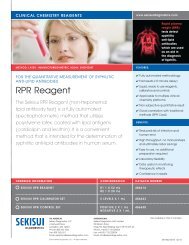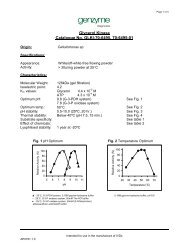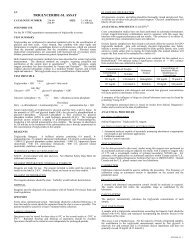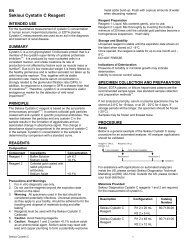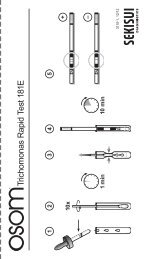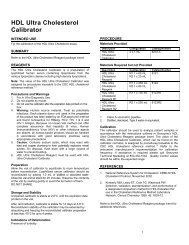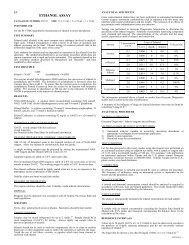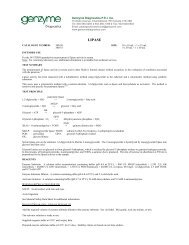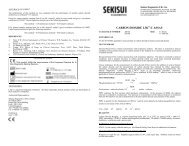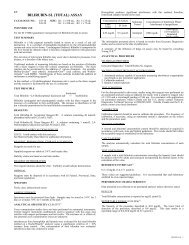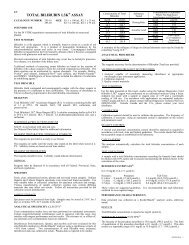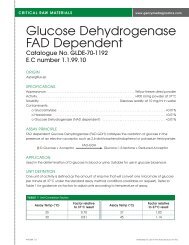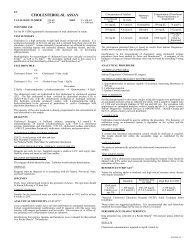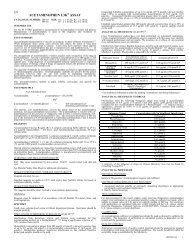OSOM C. difficile Toxin A/B Test - Sekisui Diagnostics
OSOM C. difficile Toxin A/B Test - Sekisui Diagnostics
OSOM C. difficile Toxin A/B Test - Sekisui Diagnostics
- No tags were found...
You also want an ePaper? Increase the reach of your titles
YUMPU automatically turns print PDFs into web optimized ePapers that Google loves.
SAMPLE PROCEDUREThis “Sample Procedure” is not intended as a substitute for your facility’s Procedure Manual orreagent labeling, but rather as a model for your use in customizing for your laboratory’s needs.Space has been provided within the document to allow you to update this template withinformation specific to your facility. It is suggested that a current version of the manufacturer’sdirectional insert be maintained as a supplement.11293-1, 06/11
PROCEDURETitle:<strong>Sekisui</strong> <strong>Diagnostics</strong> <strong>OSOM</strong> ® C. <strong>difficile</strong> <strong>Toxin</strong> A/B <strong>Test</strong>Procedure #:Institution:__________________________________________________________Prepared by: ___________________________ Date: __________________________Title:__________________________________________________________Accepted by: ___________________________ Date adopted: __________________Title:__________________________________________________________Reviewed by:___________________________ Date: ______________________________________________________________________________________________________________________________________________________________________________________________________________________________________________________________________________________________________________________________________________________________________________________________________________________________________________________________________________________________________________________________________________________________________________________________________________________________________________________________________________________Discontinued by:_________________________ Date:__________________________21293-1, 06/11
I. TEST NAME<strong>OSOM</strong> ® C. <strong>difficile</strong> <strong>Toxin</strong> A/B <strong>Test</strong>CLIA Complexity: Non-waivedII.INTENDED USEThe <strong>OSOM</strong> C. <strong>difficile</strong> <strong>Toxin</strong> A/B <strong>Test</strong> is an immunochromatographic assay intended for the qualitativedetection of Clostridium <strong>difficile</strong> toxins A and/or B in human stool samples. This test is intended as anaid in the diagnosis of C. <strong>difficile</strong>-associated disease (CDAD) in patients with symptoms of CDAD.III.SUMMARY AND EXPLANATION OF TESTClostridium <strong>difficile</strong> (C. <strong>difficile</strong>) is a spore-forming anaerobic gram positive bacillus that producestoxins which can cause gastrointestinal infections in humans ranging in severity from asymptomaticcarriage, to diarrhea, pseudomembranous colitis (PMC), toxic megacolon and death. 1 While infectionrates can vary dramatically depending on geography, across institutions, and from year to year, C.<strong>difficile</strong> is a common nosocomial pathogen in institutions with widespread use of broad spectrumantibiotics. Recent surveillance studies in Europe, Canada and the United States suggest that theincidence of CDAD (now increasingly referred to as “CDI”: Clostridium <strong>difficile</strong> infection) is rising, andsome regions have experienced alarming outbreaks associated with higher than expected morbidity6, 7, 11and mortality rates.Clostridium <strong>difficile</strong> has been linked to occurrences of both antibiotic-associated and nosocomialdiarrhea. Both toxigenic and non-toxigenic strains of the C. <strong>difficile</strong> organism exist, however onlytoxigenic strains are responsible for causing CDI. 4 Most pathogenic strains of C. <strong>difficile</strong> produce twotoxins, toxin A (enterotoxin) and toxin B (cytotoxin). 12 Although both toxins are generally present ininfected individuals, there have been reports of toxin A negative/toxin B positive strains of C. <strong>difficile</strong>that cause disease. 2,4,13 Because toxin must be present for CDI to occur, culture of the organism fromstool samples is not considered sufficient for diagnosis, due to the asymptomatic carriage of C. <strong>difficile</strong>among hospitalized patients. 3 The cytotoxicity assay is generally considered the reference method forC. <strong>difficile</strong> toxin tests. 5 Although accurate, the cytotoxicity assay requires specialized facilities and islabor and time intensive, requiring as much as 48 to 72 hours for results. The <strong>OSOM</strong> C. <strong>difficile</strong> <strong>Toxin</strong>A/B test is able to quickly detect the presence of toxins A and/or B in stool samples, thereby aidingclinicians in the rapid diagnosis and treatment of CDI, and in the initiation of appropriate measures tocontrol nosocomial spread of the disease.IV.PRINCIPLE OF THE TESTThe <strong>OSOM</strong> C. <strong>difficile</strong> <strong>Toxin</strong> A/B <strong>Test</strong> is a qualitative assay that employs immunochromatographic,dipstick technology. The test format is a sandwich immunoassay, with a single test zone on thenitrocellulose dipstick to detect <strong>Toxin</strong> A and/or <strong>Toxin</strong> B (blue/gray line) and a single control line zone toindicate proper sample flow (red line). The test procedure involves binding of C. <strong>difficile</strong> <strong>Toxin</strong> A and/or<strong>Toxin</strong> B from a patient stool sample to blue colored latex particles conjugated to a monoclonalantibody against <strong>Toxin</strong> B or a polyclonal antibody against <strong>Toxin</strong> A. When <strong>Toxin</strong> A and/or B is presentin the sample, it will form a partial immune complex with the antibody-conjugated colored particles.The <strong>OSOM</strong> C. <strong>difficile</strong> <strong>Toxin</strong> A/B <strong>Test</strong> stick, when placed in the sample mixture, initiates samplemigration along the nitrocellulose membrane. If C. <strong>difficile</strong> toxin A or toxin B is present, a blue/gray linewill appear in the test line region indicating a positive result. A red control line must appear for theresults to be valid. If C. <strong>difficile</strong> toxins are not present, only the red control line will appear. An invalidtest occurs when no control line appears.31293-1, 06/11
V. REAGENTS AND MATERIALS PROVIDED25 <strong>Test</strong> Sticks25 Pipettes10 Applicator Sticks35 <strong>Test</strong> Tubes2 Bottles Sample Diluent: 20 mL each(buffered solution with protein, surfactant, 0.09% sodium azide and 0.05% ProClin ® 300)2 Diluent dropper tops1 Bottle Reagent: 8 mL(antibody conjugate, buffered solution with protein, 0.09% sodium azide and 0.05% ProClin ® 300)1 Positive control: 1 mL Clostridium <strong>difficile</strong> Toxoid A and Toxoid B (contains 0.09% sodium azide)1 Negative control: 1 mL (contains 0.09% sodium azide)1 Directional Insert1 Result Interpretation Guide1 WorkstationNote: Two extra <strong>Test</strong> Sticks have been included in the kit for external QC testing. Extra <strong>Test</strong>Tubes have been provided for your convenience.VI.MATERIALS REQUIRED BUT NOT PROVIDED• A timer or watch• Vortex mixer (optional)VII.WARNINGS AND PRECAUTIONS• For in vitro diagnostic use only• Follow your clinical and/or laboratory safety guidelines in the collection, handling, storage, anddisposal of patient specimens, and all items exposed to patient specimens. 9• Pipettes, Applicator Sticks, <strong>Test</strong> Tubes, and <strong>Test</strong> Sticks are for single use only.• Discard used <strong>Test</strong> Tubes and <strong>Test</strong> Sticks in suitable biohazardous waste container.• To ensure correct volumes are delivered, hold the Sample diluent and Reagent bottles verticallywhen dispensing.• Optimal results are achieved when kit/sample conditions are followed and the test is performed perthe specified procedure.• The Sample diluent and Reagent contain ProClin ® 300 and sodium azide as preservatives. Ifsolution comes in contact with the skin or eyes, flush with ample volumes of water.• Solutions that contain sodium azide may react explosively with lead or copper plumbing. Use largequantities of water to flush discarded solutions down a sink.• Do not interchange components from different kit lots.VIII.STORAGE CONDITIONS• Store <strong>Test</strong> Sticks, Diluent and Reagent bottles tightly capped and refrigerated (2°- 8°C / 36º- 46ºF)when not in use. Do not freeze.• Allow all COMPONENTS to come to ROOM TEMPERATURE before use.• Gently MIX the <strong>OSOM</strong> C. <strong>difficile</strong> Reagent PRIOR TO EACH USE.• Recap the desiccated container immediately after removing a <strong>Test</strong> Stick.• Do not use <strong>Test</strong> Sticks or reagents after expiration date.• Discard unused <strong>Test</strong> Sticks that have been removed from the canister after 1 hour.At this facility, kits are stored: ___ .41293-1, 06/11
IX.SPECIMEN COLLECTION, STORAGE & PREPARATION• Collect specimens in a clean, leak-proof container.• Specimens that have been concentrated or collected in transport media are not suitable for use withthis test.• Use only fresh, untreated stool specimens. <strong>Test</strong> specimen as soon as possible after collection.• Specimens may be held at room temperature for up to 4 hours. Samples may also be stored at 2° -8°C (36º -46ºF) for up to 72 hours or at -20°C (- 4ºF) or below for up to 2 months. Multiple freezethawcycles should be avoided.• Allow sample to come to room temperature before use.• All specimens must be thoroughly mixed prior to testing (regardless of consistency), to obtain arepresentative sample for testing.• Use only the pipettes supplied in the kit.This facility’s procedure for patient preparation is: .This facility’s procedure for sample labeling is: .This facility’s procedure for transporting specimens is: .This facility’s procedure for rejected specimens is: .X. QUALITY CONTROL (QC)The <strong>OSOM</strong> C. <strong>difficile</strong> <strong>Toxin</strong> A/B <strong>Test</strong> provides two types of controls:• Procedural internal controls to aid in determining validity of each individual test• External positive and negative controls for C. <strong>difficile</strong> <strong>Toxin</strong> A/BInternal Procedural ControlsSeveral controls are incorporated into each <strong>Test</strong> Stick for routine quality checks.1. The appearance of the control line in the results window is an internal positive procedural control.• <strong>Test</strong> System: The appearance of the control line assures that adequate test volume waspresent and that adequate capillary migration of the sample has occurred.• Operator: The appearance of the control line indicates that adequate test volume was presentfor capillary flow to occur. If the control line does not appear by the read time, the test isinvalid.2. The clearing of the background in the results area may be documented as an internal negativeprocedural control. It also serves as an additional capillary flow control. When testing the ExternalControls, the background should appear white to light blue/gray at the read time and not interfere withthe reading of the test. When running patient samples, the background may appear light brown at theread time but should not interfere with the reading of the test. Positive samples will have a blue/graytest line and a red control line visible over the background field.....51293-1, 06/11
If the Control Line does not appear and/or the background does not clear and interferes with the testresult, the test is invalid. Call <strong>Sekisui</strong> <strong>Diagnostics</strong> Technical Assistance at (800) 332-1042 (U.S. only)if you experience a problem.External Quality Control <strong>Test</strong>ingThe <strong>OSOM</strong> C. <strong>difficile</strong> <strong>Toxin</strong> A/B <strong>Test</strong> kit includes one Positive and one Negative Control vial forexternal quality control testing. Use the Controls to ensure that the <strong>Test</strong> Sticks are functioning properlyand to demonstrate proper performance by the test operator. Quality Control requirements should beestablished in accordance with local, state and federal regulations or accreditation requirements.Minimally, <strong>Sekisui</strong> <strong>Diagnostics</strong> recommends that positive and negative external controls be run witheach new lot, shipment received, and with each new untrained operator.QC <strong>Test</strong>ing Frequency and DocumentationFor this facility, External QC is run: .Results of External QC and action(s) taken when control results are unacceptable are documented:Quality Control <strong>Test</strong>ing ProceduresThe Positive Control contains sufficient C. <strong>difficile</strong> A and B toxin to produce a visible positive testresult. The positive control is not intended to ensure precision at the analytical assay cutoff. Toperform a positive or negative control test, proceed as follows:1. Add Sample Diluent - Using the supplied dropper, fill it to the line indicated on the barrel (0.75mL)with Sample Diluent. Expel entire contents into <strong>Test</strong> Tube.2. Thoroughly mix the control bottle prior to sampling. Add one (1) drop control into the <strong>Test</strong> Tube.Mix the solution in the <strong>Test</strong> Tube by vortex mixing the sample tube (or by holding betweenthumb/forefinger and flicking/tapping the bottom of the tube ~5 times).3. Perform steps 3-5 of the TEST PROCEDURE FOR LIQUID OR SEMI-SOLID STOOLS..XI.TEST PROCEDURE FOR LIQUID, LOOSE, OR SEMI-SOLID STOOLSNOTE: If stool sample is NOT liquid or semi-solid, follow the instructions for PREPARING SAMPLESFROM FORMED STOOL SPECIMENS below before proceeding with the TEST PROCEDURE.NOTE: When opening a kit for the first time, unscrew the cap from the <strong>OSOM</strong> C. <strong>difficile</strong> SampleDiluent bottle and replace it with the dropper included in the kit. Discard the original cap.STEP 1: ADD SAMPLE DILUENTUsing the supplied dropper, fill it to the line indicated on the barrel (0.75mL)with Sample Diluent. Expel entire contents into <strong>Test</strong> Tube.Note: To prevent contamination of the Sample Diluent bottle, add SampleDiluent to the <strong>Test</strong> Tube before adding the specimen.STEP 2: ADD SAMPLE TO TEST TUBENote: Ensure that the specimen is thoroughly mixed prior to adding to the<strong>Test</strong> Tube.61293-1, 06/11
The addition of too much or too little sample or failure to perform the mixingsteps may result in invalid or false negative results.• Squeeze the bulb of the pipette supplied in the kit and insert the pipette intothe sample.• Release the pressure on the bulb to fill the barrel to the 50µL line.• Expel the entire contents of the pipette into the <strong>Test</strong> Tube. Discard thepipette in a suitable biohazardous waste container.• Mix the solution by vortex (or by holding between thumb/forefinger andflicking/tapping the bottom of the tube ~5 times).STEP 3: ADD REAGENTNote: The Reagent should be gently mixed before each use by inverting thecapped bottle 2-3 times to re-suspend any settled material.• With the Reagent bottle tip pointed straight down, dispense five (5) drops ofReagent into the diluted sample mixture.• Mix the solution by vortex (or by holding between thumb/forefinger andflicking/tapping the bottom of the tube ~5 times).STEP 4: ADD TEST STICK AND LET STANDRemove a <strong>Test</strong> Stick from the canister and recap the canister immediately. Placethe <strong>Test</strong> Stick with arrows pointing down into the solution in the sample tube. Set atimer for 20 minutes.STEP 5: READ RESULTS• At 20 minutes remove <strong>Test</strong> Stick from the <strong>Test</strong> Tube and, under adequatelighting, read the results.• When reading results, the use of the Result Interpretation Guide isrecommended.• Some positive results may be seen and reported earlier. <strong>Test</strong> is invalidbeyond the stated read time.• See Interpretation of <strong>Test</strong> Results section below.XII.PREPARING SAMPLES FROM FORMED STOOL SPECIMENSNOTE: If testing a formed stool specimen, the sample must be liquefied prior to running in theassay.1. Using the supplied dropper, add 0.75mL <strong>OSOM</strong> C. <strong>difficile</strong> Sample Diluent to a <strong>Test</strong> Tube by fillingthe dropper to the line indicated on its barrel and expelling the entire contents into the <strong>Test</strong> Tube.Note: To prevent contamination of the Sample Diluent bottle, add Sample Diluent to the<strong>Test</strong> Tube before adding the specimen.2. Collect a pea-sized (approximately this diameter ) portion of stool with the applicator stick and•transfer to the sample tube containing Sample Diluent. Do not remove the applicator stick fromthe <strong>Test</strong> Tube.3. Thoroughly mix the sample on the applicator stick in the Sample Diluent with a vortex mixer (or byholding between thumb/forefinger and flicking/tapping the bottom of the tube ~5 times) to createan even mixture. Remove applicator stick after mixing.71293-1, 06/11
4. Use the diluted stool mixture as the liquid stool sample in the procedure above beginning atSTEP 1.XIII.INTERPRETATION OF TEST RESULTSNOTE: Only <strong>Test</strong> lines in any shade of blue or gray should be read as positive.The appearance of a red Control Line at the read time, with or without a blue/gray <strong>Test</strong> Line, indicatesa valid result. A <strong>Test</strong> Line or Control Line that appears uneven in color shading is still considered avalid line. In cases of moderate or high positive specimens, some color behind the <strong>Test</strong> Line may beseen. As long as the <strong>Test</strong> Line and the Control Line are visible the results are valid.POSITIVE RESULTSA blue/gray <strong>Test</strong> Line and a red Control Line is a positive result for the detection of C. <strong>difficile</strong> Aand/or B toxin.NOTE: the red and blue/gray lines can be any shade of those colors. The lines may be lighteror darker than the lines in the picture in the directional insert. Any visible blue/gray <strong>Test</strong> Lineshould be considered positive.NEGATIVE RESULTSA red Control Line but no blue/gray <strong>Test</strong> Line is a negative result. A negative result means that eitherno C. <strong>difficile</strong> A and/or B toxin is present in the sample, or the level of the toxin in the sample is belowthe detection limit of the assay.INVALID RESULTSIf no red Control Line appears or background color makes reading the Control Line impossible, theresult is invalid. If this occurs, repeat the test using a new <strong>Test</strong> Stick or contact <strong>Sekisui</strong> <strong>Diagnostics</strong>Technical Assistance.In the event this test becomes inoperable, this facility’s course of action for patient samples is:____ .____ .XIV.LIMITATIONS• The <strong>OSOM</strong> C. <strong>difficile</strong> <strong>Toxin</strong> A/B <strong>Test</strong> is only for the qualitative detection of C. <strong>difficile</strong> A and Btoxins in human stool samples. Results should be used in conjunction with other diagnosticprocedures and in the context of the patient’s clinical information to establish a diagnosis. Anegative result may warrant additional patient follow up.• The test yields qualitative results. No quantitative or semi-quantitative interpretation should bemade based on the intensity of the <strong>Test</strong> Line color when reporting positive results.• The performance of this test with specimens other than human stool samples has not beenestablished.• The performance of this test in pediatric patients has not been evaluated.• A negative result may occur if the specimen collection is inadequate or if the toxin concentration isbelow the sensitivity of the test.81293-1, 06/11
• Although not recognized as an important human pathogen, C. sordellii produces toxins similar toC. <strong>difficile</strong> that may cause cross-reactivity in diagnostic tests that detect C. <strong>difficile</strong> toxin A and/orB. 5XV.EXPECTED RESULTSClostridium <strong>difficile</strong> is the most frequently identified cause of nosocomial diarrhea, accounting for 15%-25% of cases of antibiotic-associated diarrhea and more than 95% of cases of pseudomembranouscolitis. 1, 3 CDI is primarily a nosocomial disease, and therefore the rate of infection may vary fromlocation to location. Risks for infection include length of hospitalization, patient age, antibiotic use,severity of underlying disease and gastrointestinal surgery or procedures. 8 <strong>Test</strong> results should be usedin conjunction with the patient’s clinical information as asymptomatic colonization with C. <strong>difficile</strong> andits toxins can be seen in some healthy adults, up to 50% of cystic fibrosis patients and up to 50% ofinfants. 4In a prospective clinical study involving the <strong>OSOM</strong> C. <strong>difficile</strong> <strong>Toxin</strong> A/B <strong>Test</strong> at 5 independent sites,an overall prevalence rate of 8.0% (102/1274) was observed in freshly acquired diarrhea samplessubmitted to the laboratory for CDI testing.XVI.PERFORMANCE CHARACTERSITICSRefer to directional insert – <strong>OSOM</strong> C. <strong>difficile</strong> <strong>Toxin</strong> A/B <strong>Test</strong>XVII.REFERENCESRefer to directional insert – <strong>OSOM</strong> C. <strong>difficile</strong> <strong>Toxin</strong> A/B <strong>Test</strong>XVIII.ASSISTANCEFor assistance contact <strong>Sekisui</strong> <strong>Diagnostics</strong> Technical Assistance at (800) 332-1042.91293-1, 06/11



